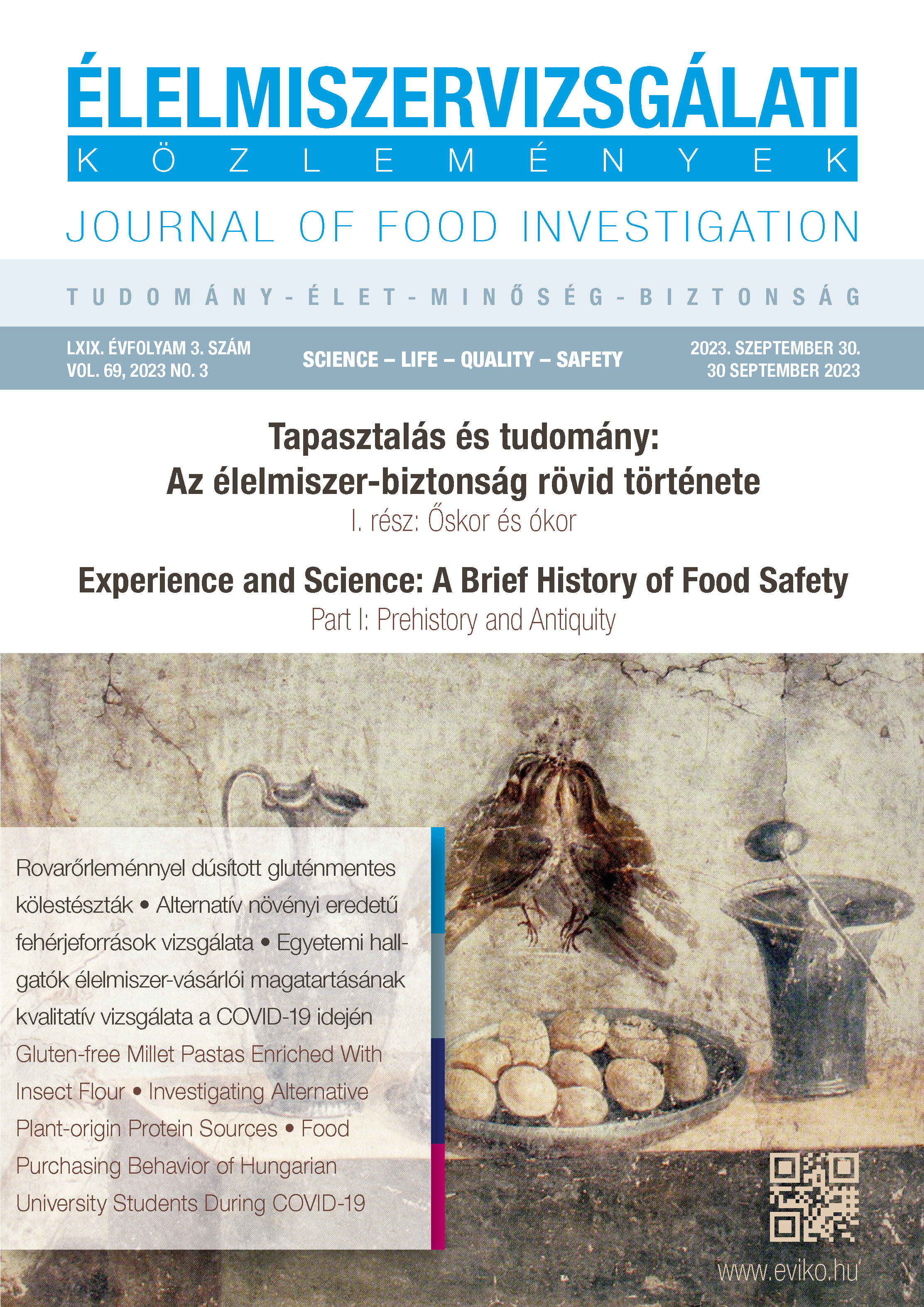Development, Chemical and Organoleptic Characterisation of Gluten-free Millet Pasta Enriched with Insect Larvae – Abstract
Main Article Content
Abstract
Traditional pasta is a common and popular product in the world, however, it is high in carbohydrates and calories and low in fiber, which can rapidly raise blood sugar levels. One of the best alternatives may be millet pasta, which is not only filling, nutrient rich, and naturally gluten-free but also contains significant amounts of essential amino acids. The question is whether it is possible to produce pasta that can be incorporated into a wide range of diets and have the lowest possible environmental impact? In our work, we have therefore enriched millet flour with insect larvae (Tenebrio molitor) at 5, 10, 15 and 20% and then carried out physical and chemical tests on the flour mixtures, dry pasta, and cooked pasta. Physical measurements have shown that the moisture content of the flour mixtures and the dry doughs decreased with enrichment (values ranging from 9.627 to 8.637% and from 0.41 to 0.400%, respectively). In terms of chemical results, cooking and drying increased the water-soluble antioxidant capacity (values ranging from 0.25 to 0.432 mg/g DM and 0.302 to 0.506 mg/g DM) and the total water-soluble polyphenol content (0.30 to 0.396 mg/g of DM and 0.65 to 0.448 mg/g of DM) of dry doughs compared to the flour mixes, while the water-soluble protein content (17.007 to 30.916 mg/g DM and 15.532 to 15.155 mg/g DM) decreased. (DM = dry material) DOI: https://doi.org./10.52091/EVIK-2023/3-2-HUN Received: June 2023 / Accepted: August 2023 1
Downloads
Article Details
References
Marques, A., Nunes, M. L., Moore, S. K., Storm, M., S. (2010): Climate change and seafood safety: Human health implications. Food Research International; 43 (7): 1766-177 DOI: https://doi.org/10.1016/j.foodres.2010.02.010
Országos Meteorológiai Szolgálat (2021): Hírek a meteorológia világából https://www.met.hu/ismeret-tar/meteorologiai_hirek/index.php?id=3113&utm_source=related&utm_medium=www.met.hu&utm_campaign=widget-6973185 Hozzáférés / Acquired: 27. 11. 2021.
Hoegh-Guldberg, O., et al (2019): The human imperative of stabilizing global climate change at 1.5°C. Science; 365 (6459): 1-11. DOI: https://doi.org/10.1126/science.aaw6974
Gomez-Zavaglia, A., Mejuto, J. C., Simal-Gandara, J. (2020): Mitigation of emerging implications of climate change on food production systems. Food Research International; 134: 109-256 DOI: https://doi.org/10.1016/j.foodres.2020.109256
González, N., Marquès, M., Nadal, M., Domingo, J. L. (2020): Meat consumption: Which are the current global risks? A review of recent (2010–2020) evidences. Food Research International; 137:109-341 DOI: https://doi.org/10.1016/j.foodres.2020.109341
Farchi, S., De Sario, M., Lapucci, E., Davoli, M., Michelozzi, P. (2017): Meat consumption reduction in Italian regions: Health co-benefits and decreases in GHG emissions. PLoS ONE; 12 (8): e0182960 DOI: https://doi.org/10.1371/journal.pone.0182960
Cheeseman, J. (2016): 7 - Food Security in the Face of Salinity, Drought, Climate Change, and Population Growth. Halophytes for Food Security in Dry Lands; 111-123 DOI: https://doi.org/10.1016/B978-0-12-801854-5.00007-8
FAO, IFAD, UNICEF, WFP, WHO (2021): The State of Food Security and Nutrition in the World 2021. Transforming food system for food security, improved nutrition and affordable healthy diets for all. FAO; Rome DOI: https://doi.org/10.4060/cb4474en
FAO, IFAD, UNICEF, WFP, WHO (2022): The State of Food Security and Nutrition in the World 2022. Repurposing food and agricultural policies to make healthy diets more affordable. FAO; Rome DOI: https://doi.org/10.4060/cc0639en
Cooper, M., Müller, B., Cafiero, C., Bayas, J. C. L., Cuaresma J. C., Kharas, H. (2021): Monitoring and projecting global hunger: Are we on track? Global Food Security; 30 DOI: https://doi.org/10.1016/j.gfs.2021.100568
WFP and FAO (2022): FAO-WFP early warnings on acute food insecurity: June to September 2022 Outlook. Hunger Hotspots; Rome https://www.fao.org/3/cc0364en/cc0364en.pdf
FAO (2022): G20: FAO says global threats to agrifood systems need complex approach https://www.fao.org/newsroom/detail/g20-fao-says-global threats-to-agrifood-systems-needcomplex-approach/en Hozzáférés / Acquired: 20. 07. 2022.
Gallo, M. (2019): Novel Foods: Insects - Safety Issues. Encyclopedia of Food Security and Sustainability; 1: 294-299. DOI: https://doi.org/10.1016/B978-0-08-100596-5.22134-3
FAO, IFAD, UNICEF, WFP, WHO (2018): The State of Food Security and Nutrition in the World 2018. Bulding climate resilience for food security and nutrition. FAO; Rome ISBN: 978-92-5-130571-3
Baiano, A. (2020): Edible insects: An overview on nutritional characteristics, safety, farming, production technologies, regulatory framework, and socio-economic and ethical implications. Trends in Food Science & Technology; 100: 35-50 DOI: https://doi.org/10.1016/j.tifs.2020.03.040
Nébih (2023): Lehet-e a tücsök titkos összetevő? https://portal.nebih.gov.hu/-/lehet-e-a-tucsok-titkos-osszetevo Hozzáférés / Acquired: 28. 02. 2023.
Gkinali, A. A., Matsakidou, A., Vasileiou, E., Paraskevopoulou, A. (2022): Potentiality of Tenebrio molitor larva-based ingredients for the food industry: A review. Trends in Food Science & Technology; 119: 495-507 DOI: https://doi.org/10.1016/j.tifs.2021.11.024
Mariod, A. A., Mirghani, M. E. S., Hussein, I. (2017): Chapter 50 - Tenebrio molitor Mealworm. Unconventional Oilseeds and Oil Sources; 331-336 DOI: https://doi.org/10.1016/B978-0-12-809435-8.00050-0
A kölesliszt tápértékadatai. https://www.balancefood.hu/spd/121340/Kolesliszt-500-g# Hozzáférés / Acquired: 01.03.2023.
Zielińska, E., Zieliński, D., Jakubczyk, A., Karaś, M., Pankiewicz., U., Flasz, B., Dziewięcka, M., Lewicki, S. (2020): The impact of polystyrene consumption by edible insects Tenebrio molitor and Zophobas morio on their nutritional value, cytotoxicity, and oxidative stress parameters. Food Chemistry; 128846 DOI: https://doi.org/10.1016/j.foodchem.2020.128846
Benzie, I. F. F., Strain, J. J. (1996): The Ferric Reducing Ability of Plasma (FRAP) as a Measure of„Antioxidant Power: The FRAP Assay”. Analytical Biochemistry; 239(1): 70- 76 DOI: https://doi.org/10.1006/abio.1996.0292
Singleton, V. L., Rossi, J. A. (1965): Colorimetry of Total Phenolic Compounds with Phosphomolybdic-Phosphotungstic Acid Reagents. American Journal of Enology and Viticulture;
: 144-158 [23] Layne, E. (1957): Spectrophotometric and Turbidimetric Methods for Measuring Proteins. Methods in Enzymology; 447-454. DOI: https://doi.org/10.1016/s0076-6879(57)03413-8
Keil, C., Grebenteuch, S., Kröncke, N. Kulow, F., Pfeif, S., Kanzler, C., Rohn, S., Boeck, G., Benning, R., Haase, H. (2022): Systematic Studies on the Antioxidant Capacity and Volatile Compound Profile of Yellow Mealworm Larvae (T. molitor L.) under Different Drying Regimes. Insects; 13 (2): 166. DOI: https://doi.org/10.3390/insects13020166
Dolinsky, M., Agostinho, C., Ribeiro, D., Rocha, G. D. S., Barosso, S. G., Ferreire, D., Polinati, R., Ciarelli, G., Fialho, E. (2015): Effect of different cooking methods ont he polyphenol concentration and antioxidant capacity of selected vegetables. Journal of Culinary Science & Technology; 14 (1): 1-12. DOI: https://doi.org/10.1080/15428052.2015.1058203

